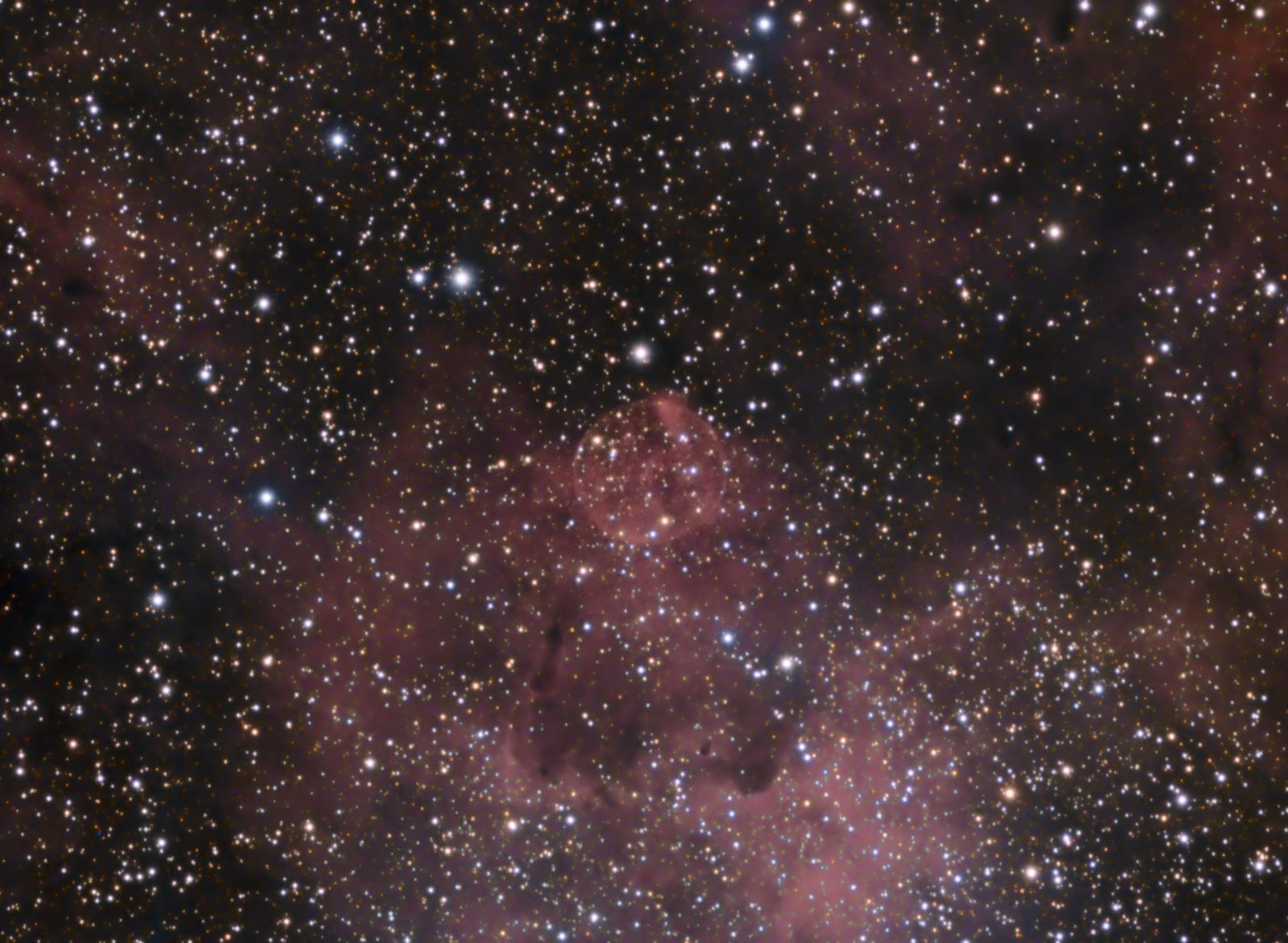Soap Bubble Nebula
 Click image for full size version
Click image for full size version
November 21, 2020
 The Soap Bubble Nebula (PN G75.5+1.7) is about 5,000 light years away, near the Crescent Nebula in Cygnus. It is extremely faint, and was discovered in 2007 by amateur astronomer Dave Jurasevich using a 160 mm refractor.
The Soap Bubble Nebula (PN G75.5+1.7) is about 5,000 light years away, near the Crescent Nebula in Cygnus. It is extremely faint, and was discovered in 2007 by amateur astronomer Dave Jurasevich using a 160 mm refractor.
The nebula is practically invisible unless H-alpha (the dominant red emission from excited hydrogen atoms) is added. The image at left shows this region imaged using only red, green and blue filters. Click on it to see an animation that shows the enhancing effect of the hydrogen emissions.
Carefully processed, this nebula reveals quite a wealth of internal structure and texture.
Tekkies:
Sky-Watcher Esprit 150 f/7 refractor, QHY 16200-A camera, Optolong Ha, R, G and B filters, Paramount MX. Acquisition with TheSkyX unguided. Focused with FocusMax 4. Automation with CCDCommander. All pre-processing and processing in PixInsight. Acquired from my SkyShed in Guelph. No Moon, average to excellent transparency and fair to above average seeing. Data acquired June 16-26, 2018.
Red: 10 x 10m = 1hr40m
Data Reduction and Cleanup
The BatchPreProcessing script was used to perform calibration, cosmetic correction and registration of all frames. ImageIntegration was used to make the Ha, R, G and B masters. DynamicCrop was used to crop all the masters identically.
RGB Creation
Creation and cleanup: ChannelCombination was used to make color image from the R, G and B masters. The RGB image was processed with DynamicBackgroundExtraction and then PhotometricColorCalibration.
Linear Noise Reduction: MultiscaleLinearTransform was used to reduce noise in the RGB image. An internal mask was used, with layer settings for threshold and strength as follows: Layer 1: 3, 0.75 Layer 2: 2, 0.6 Layer 3: 2, 0.5.
Stretching: HistogramTransformation, was applied to the RGB image to make a pleasing, bright image.
H-alpha
Deconvolution of H-alpha: A star mask was made to use as a Local Deringing Support image. A copy of the image was stretched to use as a range mask. Deconvolution was applied (80 iterations, regularized Richardson-Lucy, external PSF made using PSFImage script.
Linear Noise Reduction: MultiscaleLinearTransform was used to reduce noise in the background areas of the image. Layer settings for threshold and strength: Layer 1: 3.0 0.9 Layer 2: 2.0, 0.75 Layer 3: 1.0, 0.6 Layer 4: 0.5, 0.2.
Stretching: HistogramTransformation was applied to the H-alpha with background brightness approximately matching the RGB image.
Combining RGB and H-alpha
SynthLRGB: The processed H-alpha was applied to the RGB image using LRGBCombine.
Additional Processing
Noise Reduction and Re-Stretch: TGVDenoise was applied in L*a*b* mode (1000 iterations with convergence on and set to 0.004) with a range mask used to protect high signal areas. HistogramTransformation was used to raise the black point (but with no clipping).
Contrast Enhancement: LocalHistogramEqualization was applied twice using a mask to select the bright parts of the nebula and protect stars and background. The first pass was with a scale of 50 (max contrast 1.5, strength 0.32, 1 iteration), followed by a scale of 150 (max contrast 1.5, strength 0.22, 1 iteration).
Sharpening: Using a mask to protect stars, background and dim nebulosity, MultiscaleLinearTransform was applied to sharpen layers 2 and 3 (bias of 0.1 and 0.12, respectively).
Reduce Star Size: Using a mask to select stars, MorphologicalTransformation was applied (morphological selection mode. 2 iterations, amount 0.56, Selection = 0.11).
Final Steps: Background, nebula and star brightness, contrast and saturation were adjusted in several iterations using Curves with masks as required.






AWESOME PICTURE! I LOVE all your pictures!
Thanks Randall
Beautiful Ron. I have photographed the bubble nebula, but your results are always amazing. Thanks for sharing.
Thanks Chris!